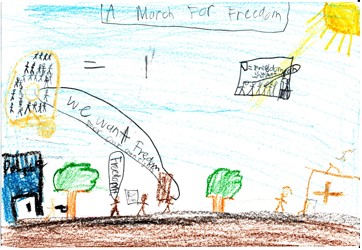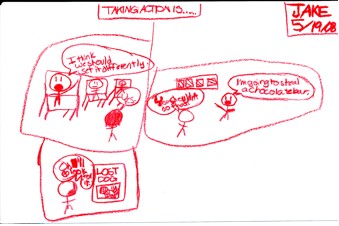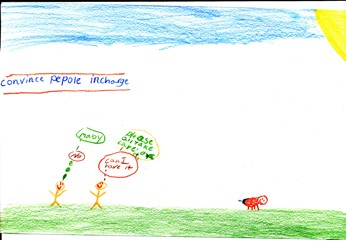Taking Action through Emotional Connections
by Kathryn Tompkins, Fourth Grade, Van Horne Elementary School
Classroom studies of global issues often focus on immersing students in a wealth of information to persuade them of the dire state of overpopulation, hunger, violence, homelessness, or the abuse of human rights in different parts of the world. Students may intellectually come to recognize the immense needs that exist in the world, but they do not always develop a sense of caring or emotion towards those issues. They understand the issues with their minds, not their hearts, and so the passion that drives taking action for social change is missing.
My experiences with literature have persuaded me that when students make an emotional connection to particular characters in a book, the connection of heart and mind combine to create a strong sense of connection and desire for action. This need for human connection also carries into their belief that characters who are in difficult situations have a greater chance of hope for the future if they have supportive relationships. Students attach themselves to characters who are going through difficult times and worry about them, but feel that everything will work out as long as the character has a caring relationship with someone. They explore these relationships within the story and, in turn, develop relationships with the characters that lead them to want to take action in similar real-life situations in the world.
As a teacher, I search for literature that contains characters who have the potential to come alive for students and with whom they can develop a caring relationship. Rosenblatt (1995) argues that, “The student’s personal response to literary works will be primarily colored by his attitudes toward the characters and situations they present. To ignore these student reactions destroys the very basis on which any greater literary sensitivity can be built” (p. 225). This focus on character is especially important in international books where the setting and issues may be far removed from students’ own life experiences. I know that if the character is someone with whom they can develop a relationship, then I can encourage the connection that makes a book compelling for kids.
Our school focus this year was on the concept of journeys as a frame for many different explorations in our Learning Lab and classrooms. We began by trying to determine our own definition of journey. We talked about journeys in a physical sense (taking a different path, trying new things) and journeys in an emotional sense (births, deaths, experiences that change us). We used their thinking about journeys from a brainstormed web to develop picture book texts sets on different aspects of journeys so that they could explore these issues in greater depth. One text set that was especially powerful for students was the text set on emotional and spiritual journeys.
This text set included several books that became pivotal to our year. The first story that affected students on an emotional level was Brothers in Hope (Williams, 2005), a picture book about the lost boys of the Sudan. The students were especially taken with the bond between the older children who had to care for younger children as they fled the violence. Many of the boys started their day peacefully tending livestock, only to witness their families being killed and their villages burned as they fled from the fighting. The older boys took care of the younger ones and had to find food and safe places to rest as they walked and walked and walked, trying to get to somewhere safe.
Alex worried about how one boy could possibly take care of another without adults to help. Victoria was mortified that they had to survive by eating bark from trees. The students felt an emotional connection to the characters because they were children who were in a situation where they had to take care of other children. They tried to put themselves in that situation and imagined suddenly having to go from being a child to being a caretaker because of war. They worried about the boys and wanted to know what had happened to them since this book had been written. Because the characters actually existed as real people, students were especially perplexed about the horrible situation that these boys faced. They couldn’t stop trying to imagine how they would handle this situation, but seemed to gain comfort in the realization that the boys had each other. They gave credit for the boys’ survival to their bonds with each other.
This book gave the students information about current events in several African countries, and also encouraged a caring attitude that influenced their desire to help. Our first reading of Brothers in Hope indicated that this was a book that would continue to be significant for us as a class. Our discussion started students on a journey of emotional connections to the events taking place in our world.
Students’ focus on the relationships between characters was evident in their responses to Ziba Came on a Boat (Lofthouse, 2007), which highlights the relationship between a refugee mother and child. A young girl is forced to flee the fighting in her homeland of Afghanistan on a crowded fishing boat. As she drifts off to sleep she has peaceful dreams about her family and the comforts of home. When she wakes up in her mother’s arms she doesn’t know where she is going but she hopes for safety and freedom. The students recognized that she had a good life until the gunfire came and she was forced to leave her home. They were upset because they felt that the book didn’t have an ending. They wanted to know that Ziba and her mother had arrived safely somewhere and started a new life. They didn’t like that the book left her still traveling on the ocean. The only comfort they seemed to gain from the book was that she was with her mother. The relationship was important to them because they believed that there was a better chance of survival if she was with someone close to her. As long as Ziba had her mother to take care of her, she would be okay.
Friends are important in the life of fourth-graders so the story of a friendship during a time of war really got them thinking about the significance of relationships. In Four Feet, Two Sandals (Williams & Mohammed, 2007), relief workers drop off clothing at a refugee camp in Pakistan. When two young girls each end up with one sandal from a matching pair, they decide that having four feet and two sandals is not a problem when you can share with a friend. One morning a list of refugees who have been cleared to go to America is posted, and only one girl’s name is included. Both girls want the other to keep the two sandals, but in the end each takes one sandal as a way to remember the other person. I was intrigued that students focused almost exclusively on the strength of the friendship and did not discuss the issue of the girls living in a refugee camp. They were sure the friendship would last and that the girls would reunite in America. Danielle said, “Even though she had no shoes, she had friendship.” The students didn’t seem to worry that the girls had been forced to flee their homes due to fighting because they felt reassured by the relationship between the girls. The girls reflected the need to have someone to care for and to be cared for by something as small as sharing a pair of sandals.
As we continued to discuss journeys, students kept returning to their desire to take action to help people who are dealing with situations like those in the books we were reading. Their talk came back to Brothers in Hope and students researched and shared additional information on the problems facing the people of Sudan. They had been moved by the stories of children escaping war to go to refugee camps and felt such emotional connections to the characters in the books that they knew they had to do something to help real refugees in the world.
We talked about refugee camps and did some research in the computer lab. This research provided students with an understanding of the reasons for the violence that led people to flee their homes and of the situations they faced in the refugee camps. I found an organization that was geared towards children making a difference in the lives of refugees from Darfur and contacted the organization. The students were excited about this organization and came up with ways they thought they could help that organization’s efforts. They decided that we needed to raise money to buy needed items for the refugee camps. We learned that many children received their protein from drinking goat milk. We found pictures on-line of children herding their flocks of goats and playing with them. The students loved that the goats were pets as well as a way to stay alive.
The students decided that one way we could raise money was to go to each classroom and explain the situation in Darfur, in particular that people had been forced from their homes. They seriously discussed the differences between what they might tell a Kindergarten class as opposed to a fifth-grade class and thought they shouldn’t discuss too much violence with young kids. Their idea was to explain the situation in Darfur and ask students to each bring in $1. Each student who contributed $1 would get a little paper goat on which they could write their name to post in a huge “goat pen” in the main hallway of the school. The words “I Made a Difference,” were printed in large letters over this pen. As the students shared with different classes, our goat pen quickly had to be enlarged.
Another way that they decided to raise money was a bake sale. They talked to their parents about baking goodies and announced their plans to the school, selling out quickly the day of the bake sale. Another class had a second bake sale to help the cause. They also decided to make money by having a walk-a-thon. They asked their parents and friends to sponsor them and we made punch-cards to keep track of how many laps they walked around the field. At the end of our efforts, we were able to purchase 12 goats and 1 donkey for refugee families in Darfur. The students beamed with pride because they had been the ones to organize and raise the money to help people in dire situations. I think it was significant that the money the students raised was used to purchase animals that allowed children in Darfur to take responsibility for their own survival. We were not just engaged in charity work of giving to “the less fortunate,” but saw ourselves as taking action with the children in Darfur.
Kaye (2004) argues that engaging students in these kinds of experiences is essential to creating an understanding of democracy. “When young people recognize their vital role in improving society, working for social justice, and caring for the environment, then they truly understand the concept of democracy. Students recognize how participation and the ability to respond to authentic needs improve the quality of life in the community, which may lead to a lifelong ethic of service and civic participation” (p. 13). Students were taking action for the greater good and through that experienced the importance of participating with others to improve a difficult situation. One way in which they demonstrated this understanding was to create sketch-to-stretch images to visually symbolize what taking action meant to them.
In reflecting over the events that led to their action, I realized the significance of the books in which they were able to make emotional connections with characters. Students became engaged in directions that I never expected because they cared about the characters and what was happening to them. This emotional connection encouraged them to gain knowledge about refugees and what happens when someone is forced to flee their home. They were amazed by the capacity of some refugees to care for others even when their own lives are falling apart. They learned about people in unimaginable situations who put their own needs aside to care for each other, and it made them want to take action. Through our exploration of emotional connections to characters in literature, students gained the knowledge and motivation to work for social justice and to connect with refugees halfway across the world.
References
WOW Stories, Volume I, Issue 2 by Worlds of Words is licensed under a Creative Commons Attribution-NonCommercial-ShareAlike 4.0 International License.
Based on a work at https://wowlit.org/on-line-publications/stories/storiesi2/.




One thought on “WOW Stories: Connections from the Classroom”